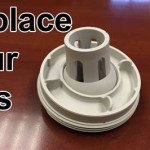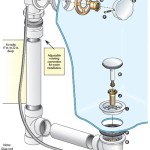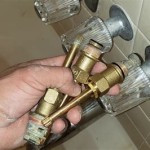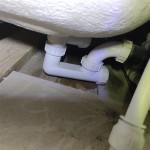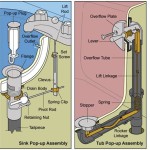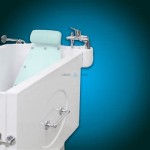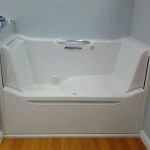Bathtub With Built-In Overflow: A Comprehensive Guide
The bathtub has evolved from a simple vessel for bathing into a centerpiece of bathroom design, offering relaxation and therapeutic benefits. A key, and often overlooked, feature of many modern bathtubs is the built-in overflow. This seemingly minor element plays a crucial role in safety and functionality, preventing water damage and ensuring a positive bathing experience. This article provides a comprehensive overview of bathtubs with built-in overflows, exploring their purpose, types, installation, maintenance, and considerations for choosing the right model.
Understanding the Purpose of the Overflow Drain
The primary purpose of a bathtub's built-in overflow is to prevent the tub from overflowing and causing water damage to the surrounding bathroom floor, walls, and potentially even the structure of the building. Without an overflow drain, if the faucet is left running unintentionally or if the water level rises excessively during bathing, water would spill over the edge of the tub. This can lead to costly repairs, mold growth, and other issues associated with water damage.
The overflow drain typically consists of an opening located near the top of the bathtub, connected to a drainpipe that leads to the main plumbing drain. When the water level reaches the overflow opening, the excess water automatically drains away, preventing the bathtub from overflowing. This safety mechanism is particularly important in homes with children or for individuals who may be prone to forgetting to turn off the faucet.
Beyond its primary function of preventing overflows, the built-in overflow also contributes to a more comfortable and worry-free bathing experience. Knowing that the tub is equipped with this safety feature allows bathers to relax and enjoy their soak without constantly monitoring the water level. It also provides a degree of safety against accidental overfilling, which can occur due to distractions or unexpected interruptions.
Types of Bathtub Overflows
While the basic function of a bathtub overflow remains consistent, there are several different types of designs available, each with its own aesthetic and functional characteristics. Understanding these different types can help in selecting a bathtub that meets both practical needs and design preferences.
Slotted Overflow: This is one of the most common types of overflow designs. It features a series of vertical or horizontal slots located along the side of the bathtub, near the top. The slots allow excess water to drain away when the water level reaches a certain point. Slotted overflows are typically simple in design and relatively easy to clean. They are often found in a wide range of bathtub styles and materials.
Circular Overflow: This type of overflow features a circular opening, often covered by a decorative plate or grid. The circular opening allows water to drain away when the water level rises above the opening. Circular overflows can offer a more streamlined and modern aesthetic compared to slotted overflows. The design may also make it slightly easier to clean, as there are fewer small crevices where debris can accumulate.
Toe-Tap Overflow: This type of overflow is integrated with the drain stopper mechanism. A toe-tap drain allows the user to open and close the drain by simply pressing on the stopper with their toe. The overflow is typically incorporated into the stopper mechanism, allowing excess water to drain away when the drain is closed. Toe-tap overflows offer a convenient and aesthetically pleasing design, as they eliminate the need for a separate overflow plate or cover.
Cable-Driven Overflow: This type of overflow utilizes a cable mechanism to control the drain stopper. The overflow is often integrated into the cable mechanism, allowing the user to control both the drain stopper and the overflow function with a single lever or knob. Cable-driven overflows can offer a more precise and reliable control over the drain and overflow, as the cable mechanism provides a direct connection between the lever and the stopper.
Integrated Overflow: In some high-end bathtubs, the overflow is seamlessly integrated into the bathtub's design, making it virtually invisible. This type of overflow often utilizes a hidden channel or opening to drain away excess water. Integrated overflows offer a clean and minimalist aesthetic, as they eliminate the need for any visible overflow components. However, they can be more complex to install and maintain compared to other types of overflows.
Installation and Maintenance of Bathtub Overflows
Proper installation and regular maintenance of the bathtub overflow are essential for ensuring its proper functioning and preventing water damage. Installation should be performed by a qualified plumber to ensure that all connections are secure and leak-proof.
Installation Considerations: The installation process typically involves connecting the overflow drainpipe to the main plumbing drainpipe. The plumber will need to ensure that the drainpipe is properly aligned and sealed to prevent leaks. The overflow drain should also be positioned correctly on the bathtub wall to ensure that it is aligned with the overflow opening. It is crucial to follow the manufacturer's instructions carefully during installation to avoid any issues.
Maintenance Tips: Regular cleaning is essential for preventing clogs and maintaining the proper flow of water through the overflow drain. Over time, hair, soap scum, and other debris can accumulate in the drain, restricting the flow of water and potentially causing overflows. To clean the overflow drain, the overflow plate or cover should be removed. Use a small brush or tool to remove any visible debris. A mixture of baking soda and vinegar can also be poured down the drain to help dissolve any stubborn clogs. Allow the mixture to sit for several minutes before flushing with hot water.
Troubleshooting Common Issues: One common issue with bathtub overflows is a slow drain. This can be caused by a partial clog in the drainpipe. To resolve this issue, try using a plunger to dislodge the clog. If the plunger does not work, a drain snake can be used to reach deeper into the drainpipe and remove any obstructions. In some cases, the slow drain may be caused by a build-up of mineral deposits in the drainpipe. In this case, a chemical drain cleaner may be necessary. However, it is important to use chemical drain cleaners carefully, as they can be corrosive and potentially damage the plumbing system.
Professional Assistance: If you are unable to resolve the issue yourself, it is best to contact a qualified plumber for assistance. A plumber will have the tools and expertise to diagnose the problem and perform the necessary repairs. Regular inspections by a plumber can also help to identify potential issues before they become serious problems.
Choosing the Right Bathtub with a Built-In Overflow
Selecting the right bathtub with a built-in overflow involves considering various factors, including the size and shape of the bathroom, the desired style and aesthetic, and the budget. It is important to carefully evaluate these factors to ensure that the chosen bathtub meets both practical needs and design preferences.
Size and Shape: The size and shape of the bathroom will dictate the size and shape of the bathtub that can be accommodated. Measure the available space carefully before selecting a bathtub. Consider the location of the drain, as this will affect the placement of the bathtub. Also, consider the shape of the bathtub. Common shapes include rectangular, oval, and corner bathtubs. Choose a shape that complements the overall design of the bathroom.
Material: Bathtubs are available in a variety of materials, each with its own unique properties and advantages. Acrylic bathtubs are lightweight, durable, and relatively inexpensive. Cast iron bathtubs are heavy, durable, and excellent at retaining heat. Steel bathtubs are lightweight and affordable but may not retain heat as well as other materials. Copper bathtubs are visually striking and offer excellent heat retention but can be expensive. Consider the pros and cons of each material before making a decision.
Style and Design: The style and design of the bathtub should complement the overall aesthetic of the bathroom. Consider the color, finish, and shape of the bathtub. Also, consider the type of overflow design. Choose a style that reflects personal taste and creates a relaxing and inviting bathing environment.
Budget: The cost of a bathtub can vary widely depending on the size, material, style, and features. Set a budget before starting the shopping process. Compare prices from different retailers and consider the long-term value of the bathtub. A higher-quality bathtub may cost more initially but may last longer and require less maintenance in the long run.
Features and Accessories: Consider any additional features or accessories that may be desired. Some bathtubs come with built-in jets for hydrotherapy. Others have integrated lighting or sound systems. Optional accessories include grab bars, bath pillows, and soap dishes.
By carefully considering these factors, individuals can select the right bathtub with a built-in overflow that meets their specific needs and preferences, ensuring a safe, comfortable, and enjoyable bathing experience.

Kingston Brass Aqua Eden 67 In X 32 Acrylic Freestanding Soaking Bathtub Glossy White With Built Overflow Drain Hvtov543023 The Home Depot

Integral Waste And Overflow

Integral Waste And Overflow

Integral Waste And Overflow

White Vitality 60 Alcove Soaking Bathtub With Self Leveling Base Overflow Drain Trim Kit Included Free Home Interiors And Beyond

American Standard Town Square S 68 X 36 Inch Freestanding Bathtub Center Drain With Integrated Overflow Com

Azi Bank Series 65 X 31 Freestanding Glossy White Bathtub With Bui Us Bath

Azi Bank Series 65 X 31 Freestanding Glossy White Bathtub With Bui Us Bath

Abruzzo 59 06 In X 30 71 Contemporary Soaking Tub Acrylic Freestanding Bathtub With Overflow And Drain Gloss White 22a04 60 The Home Depot

Woodbridge Dover 54 In Heavy Duty Acrylic Slipper Clawfoot Bathtub White Faucet Claw Feet Drain Overflow Oil Rubbed Broe Hbt7009 The Home Depot

